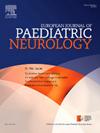Reduced elbow muscle strength in children and adolescents with Charcot-Marie-Tooth disease: a case control study
IF 2.3
3区 医学
Q3 CLINICAL NEUROLOGY
引用次数: 0
Abstract
Background
Charcot-Marie-Tooth disease type 1 (CMT1) is a prevalent inherited neuropathy characterized by progressive sensory and motor deficits affecting the peripheral nervous system. Although muscle weakness is commonly seen in the hands, weakness of more proximal muscles has been observed in adults. In childhood, the muscle strength of the upper limbs must be explored to understand the natural history of the disease.
Objective
This study assessed differences in the muscle strength of elbow flexors and extensors between typically developing children and adolescents (as controls) and those with CMT1 using isometric and isokinetic contractions.
Method
Eighteen children and adolescents with CMT1 participated and were matched with 36 controls in this case control study (1:2). The peak torque of elbow flexors (EFL) and extensors (EEX) was assessed using an isokinetic dynamometer through isometric and isokinetic contractions at a speed of 120°.s-1. Descriptive, t-tests and ANOVA were used for the statistical analysis.
Results
The CMT group exhibited significantly lower peak torque values across all assessed muscles and contraction types compared to the control group (p ≤ 0.05). Additionally, the isokinetic peak torque comparing the values of the elbow flexors with elbow extensors showed a significant difference to the control group (p ≤ 0.05). The intra-group analysis considering types of contractions showed no statistical difference.
Conclusion
Children with CMT1 presented proximal weakness in the muscles of the upper limbs, not only in the distal hand muscles. Health professionals should pay attention to the assessment and rehabilitation procedures with the aim of contributing to quality of life in the subsequent stages of life.
患有 Charcot-Marie-Tooth 疾病的儿童和青少年肘部肌肉力量减弱:病例对照研究
背景:1型腓骨肌萎缩症(CMT1)是一种常见的遗传性神经病变,其特征是累进性感觉和运动障碍影响周围神经系统。虽然肌肉无力常见于手部,但在成人中也观察到更多的近端肌肉无力。在儿童时期,必须探索上肢的肌肉力量,以了解疾病的自然史。目的:本研究评估正常发育儿童和青少年(作为对照)与CMT1患者肘关节屈肌和伸肌肌肉力量的差异。方法18名患有CMT1的儿童和青少年参与了本病例对照研究,并与36名对照组进行了配对(1:2)。使用等速测力仪通过等速和等速收缩以120°s-1的速度评估肘关节屈肌(EFL)和伸肌(EEX)的峰值扭矩。采用描述性检验、t检验和方差分析进行统计分析。结果与对照组相比,CMT组在所有评估的肌肉和收缩类型中显示出明显较低的峰值扭矩值(p≤0.05)。此外,肘关节屈肌和伸肌的等速峰值扭矩值与对照组相比有显著差异(p≤0.05)。考虑宫缩类型的组内分析无统计学差异。结论CMT1患儿不仅表现为手部远端肌肉无力,还表现为上肢近端肌肉无力。保健专业人员应注意评估和康复程序,目的是提高生命后续阶段的生活质量。
本文章由计算机程序翻译,如有差异,请以英文原文为准。
求助全文
约1分钟内获得全文
求助全文
来源期刊
CiteScore
6.30
自引率
3.20%
发文量
115
审稿时长
81 days
期刊介绍:
The European Journal of Paediatric Neurology is the Official Journal of the European Paediatric Neurology Society, successor to the long-established European Federation of Child Neurology Societies.
Under the guidance of a prestigious International editorial board, this multi-disciplinary journal publishes exciting clinical and experimental research in this rapidly expanding field. High quality papers written by leading experts encompass all the major diseases including epilepsy, movement disorders, neuromuscular disorders, neurodegenerative disorders and intellectual disability.
Other exciting highlights include articles on brain imaging and neonatal neurology, and the publication of regularly updated tables relating to the main groups of disorders.

 求助内容:
求助内容: 应助结果提醒方式:
应助结果提醒方式:


